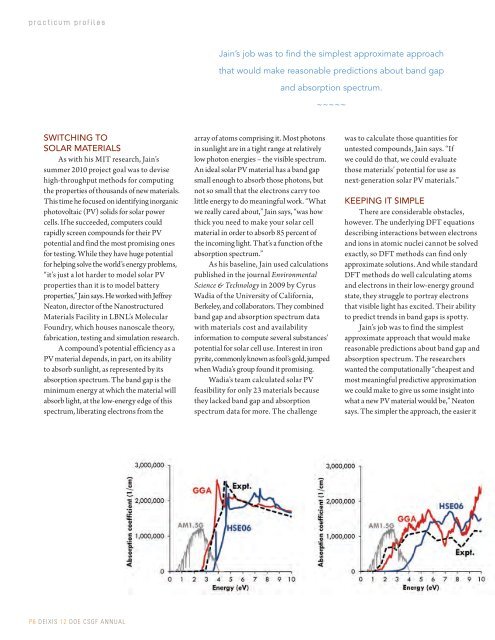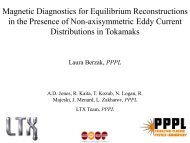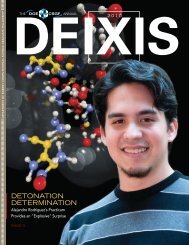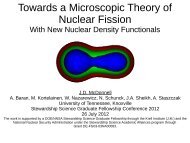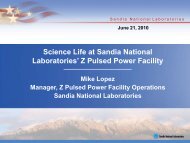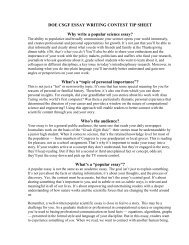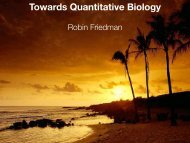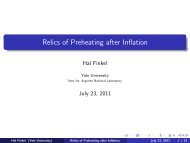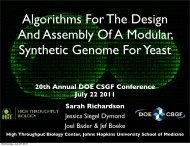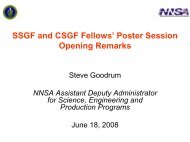2012 - Krell Institute
2012 - Krell Institute
2012 - Krell Institute
You also want an ePaper? Increase the reach of your titles
YUMPU automatically turns print PDFs into web optimized ePapers that Google loves.
practicum profiles<br />
Jain’s job was to find the simplest approximate approach<br />
that would make reasonable predictions about band gap<br />
and absorption spectrum.<br />
~~~~~<br />
SWITCHING TO<br />
SOLAR MATERIALS<br />
As with his MIT research, Jain’s<br />
summer 2010 project goal was to devise<br />
high-throughput methods for computing<br />
the properties of thousands of new materials.<br />
This time he focused on identifying inorganic<br />
photovoltaic (PV) solids for solar power<br />
cells. If he succeeded, computers could<br />
rapidly screen compounds for their PV<br />
potential and find the most promising ones<br />
for testing. While they have huge potential<br />
for helping solve the world’s energy problems,<br />
“it’s just a lot harder to model solar PV<br />
properties than it is to model battery<br />
properties,” Jain says. He worked with Jeffrey<br />
Neaton, director of the Nanostructured<br />
Materials Facility in LBNL’s Molecular<br />
Foundry, which houses nanoscale theory,<br />
fabrication, testing and simulation research.<br />
A compound’s potential efficiency as a<br />
PV material depends, in part, on its ability<br />
to absorb sunlight, as represented by its<br />
absorption spectrum. The band gap is the<br />
minimum energy at which the material will<br />
absorb light, at the low-energy edge of this<br />
spectrum, liberating electrons from the<br />
array of atoms comprising it. Most photons<br />
in sunlight are in a tight range at relatively<br />
low photon energies – the visible spectrum.<br />
An ideal solar PV material has a band gap<br />
small enough to absorb those photons, but<br />
not so small that the electrons carry too<br />
little energy to do meaningful work. “What<br />
we really cared about,” Jain says, “was how<br />
thick you need to make your solar cell<br />
material in order to absorb 85 percent of<br />
the incoming light. That’s a function of the<br />
absorption spectrum.”<br />
As his baseline, Jain used calculations<br />
published in the journal Environmental<br />
Science & Technology in 2009 by Cyrus<br />
Wadia of the University of California,<br />
Berkeley, and collaborators. They combined<br />
band gap and absorption spectrum data<br />
with materials cost and availability<br />
information to compute several substances’<br />
potential for solar cell use. Interest in iron<br />
pyrite, commonly known as fool’s gold, jumped<br />
when Wadia’s group found it promising.<br />
Wadia’s team calculated solar PV<br />
feasibility for only 23 materials because<br />
they lacked band gap and absorption<br />
spectrum data for more. The challenge<br />
was to calculate those quantities for<br />
untested compounds, Jain says. “If<br />
we could do that, we could evaluate<br />
those materials’ potential for use as<br />
next-generation solar PV materials.”<br />
KEEPING IT SIMPLE<br />
There are considerable obstacles,<br />
however. The underlying DFT equations<br />
describing interactions between electrons<br />
and ions in atomic nuclei cannot be solved<br />
exactly, so DFT methods can find only<br />
approximate solutions. And while standard<br />
DFT methods do well calculating atoms<br />
and electrons in their low-energy ground<br />
state, they struggle to portray electrons<br />
that visible light has excited. Their ability<br />
to predict trends in band gaps is spotty.<br />
Jain’s job was to find the simplest<br />
approximate approach that would make<br />
reasonable predictions about band gap and<br />
absorption spectrum. The researchers<br />
wanted the computationally “cheapest and<br />
most meaningful predictive approximation<br />
we could make to give us some insight into<br />
what a new PV material would be,” Neaton<br />
says. The simpler the approach, the easier it<br />
P6 DEIXIS 12 DOE CSGF ANNUAL


